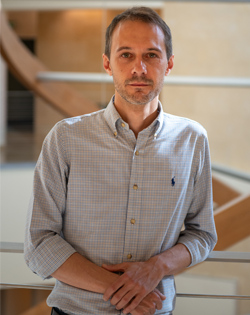
San Raffaele Telethon Institute for Gene Therapy
Stem Cells & Timing of Neural Development in Health and Disease


The construction of the mature brain relies on the largely sequential execution of basic developmental steps. How this progression is controlled at temporal level remains largely unknown. Our lab works at the intersection of human stem cell biology and experimental neuroscience. We investigate how temporal information is encoded in the developing brain and how it is modulated across human neuron types to coordinate their assembly into mature networks. We use cutting-edge in vitro human pluripotent stem cells (hPSC) differentiation technologies to recapitulate neural developmental trajectories and combine them with cell & genetic engineering, molecular and functional profiling and cell transplantation assays to model human neurobiology. Our vision is to uncover how the pace of cell maturation contributes to the emerging properties of the human brain and how alterations in maturation trajectories contribute to neurological disorders.
The Ciceri's lab is generously funded by a Giovanni Armenise-Harvard Career Development Award.
Research Activity
Unraveling key regulators of developmental timing
Neuronal maturation is a growth process marked by the progressive acquisition of multiple distinct phenotypes. These include morphological changes in size and complexity, the acquisition of excitability and synaptic function and shifts in metabolism to support the growing energetic demand. Here, we aim to decipher a network of molecular pathways, including candidate epigenetic mechanisms, and the underlying regulatory logic that control the temporal acquisition of distinct neuronal maturation phenotypes. We will explore whether manipulation of this network can revert the maturation process or specific phenotypes and whether the combined manipulation of intrinsic and extrinsic, environmental regulators of maturation timing unlock late maturation stages in stem cells-based human model systems.
Understanding the coordination of maturation timing across CNS neuron types
The pace of brain developments displays substantial variation across species and within a given species across neuron types and brain regions. It takes almost two decades to build a fully functional cerebral cortex in humans. In contrast, neurons in the spinal cord and other regions mature at a much faster pace. By using region-specific hPSC differentiation assays we investigate the mechanisms that enable the coordination of maturation rates across neuron types. We will determine shared and unique molecular and functional maturation programs and temporal scaling factors across neuron types. The final goal is to identify upstream regulators responsible for their coordinated maturation and develop strategies to accelerate, delay and potential revert the maturation process in hPSC models.
Dissecting how disruption of neuronal maturation trajectories leads to disease.
The slow maturation of neurons in the human cerebral cortex is linked to the emergence of the unique properties of the human brain, including its complex cognitive abilities. However, its protracted developmental timeline makes the human brain particularly vulnerable to genetic and environmental insults that lead to pathological disfunctions of neuronal networks. Here, we aim to establish a novel experimental platform for disease modelling applications by combining advanced hPSC-based technologies to precisely control developmental stages and maturation timing in vitro and upon transplantation in the developing mouse brain in vivo. This platform will allow us to map the impact of disease risk factors onto maturation trajectories at high precision, test mechanisms of disease priming and convergence and dissect cell-type and stage-specific vulnerabilities.
.
Xu N, Cho HS, Hackland JOS, Benito-Kwiecinski S, Saurat N, Harschnitz O, Russo MV, Garippa R, Ciceri G*, Studer L*. Genome-wide CRISPR screen identifies Menin and SUZ12 as regulators of human developmental timing. Nature Cell Biology, 2025. *co-corresponding author.
Ciceri G*, Baggiolini A, Cho HS, Kshirsagar M, Benito-Kwiecinski S, Walsh RM, Aromolaran KA, Gonzalez-Hernandez AJ, Munguba H, Koo SY, Xu N, Sevilla KJ, Goldstein PA, Levitz J, Leslie CS, Koche RP, Studer L*. An epigenetic barrier sets the timing of human neuronal maturation. Nature, 2024. *co-corresponding author.
Hergenreder E, Minotti A, Zorina Y, Oberst P, Zhao Z, Munguba H, Calder E, Baggiolini A, Walsh R, Liston C, Levitz J, Garippa R, Chen S, Ciceri G, Studer L. Combined small molecule treatment accelerates timing of maturation in human pluripotent stem cell-derived neurons. Nature Biotechnology, 2024.
Walsh R*, Luongo R*, Giacomelli E*, Ciceri G*, Rittenhouse C*, Verrillo A, Galimberti M, Bocchi V, Wu Y, Xu N, Mosole S, Muller J, Vezzoli E, Jungverdorben J, Zhou T, Baker RA, Cattaneo E, Studer L, Baggiolini A. Generation of human cerebral organoids with structured outer subventricular zone. Cell Reports, 2024. *co-first author.
Ciceri G* & Studer L*. Epigenetic control and manipulation of neuronal maturation timing. Current Opinion in Genetics & Development, 2024. *Co-corresponding author.
Nair VP, Liu H, Ciceri G, Jungverdorben J, Frishman G, Tchieu J, Cederquist GY, Rothenaigner I, Schorpp K, Klepper L, Walsh RM, Kim TW, Cornacchia D, Ruepp A, Mayer J, Hadian K, Frishman D, Studer L, Vincendeau M. Activation of HERV-K(HML-2) disrupts cortical neuronal patterning and neuronal differentiation by increasing NTKR3. Cell Stem Cell, 2021
Llorca A, Ciceri G, Beattie R, Wong FE, Diana G, Serafeimdou E, Fernandez-Otero M, Streicher C, Arnold S, Meyer M, Hyppermeyer S, Maravall M and Marin O. A stochastic framework of neurogenesis underlies the assembly of neocortical cytoarchitectures. eLife, 2019
Martínez-Martínez MA*, Ciceri G*, Espinós A*, Fernández V, Marín O and Borrell V. Extensive branching of radially migrating neurons in the mammalian cerebral cortex. * co-first author. Journal of Comparative Neurology, 2019
Dehorter N, Ciceri G, Bartolini G, Lim L, del Pino I, Marín O. Tuning of fast-spiking interneuron properties by an activity-dependent transcriptional switch. Science, 2015
Ciceri G, Dehorter N, Sols I, Huang ZJ, Maravall M, Marín O. Lineage-specific laminar organization of cortical GABAergic interneurons. Nat Neurosci, 2013
